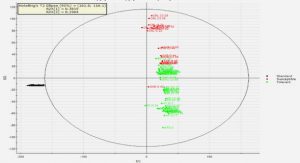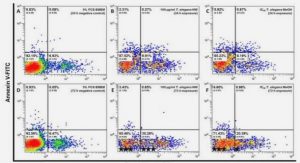Get Complete Project Material File(s) Now! »
Animal coronaviruses
Coronaviruses have a broad host range among both domestic and wild animals. Non-exhaustively, they can infect bats (Bat-CoVs), swine (TGEV, PEDV), cats (FCoV), mice (MHV), birds (IBV), dogs (CCoV), horses (ECoV), cattle (BCoV), dolphins (BdCoV HKU22)… Most animal coronaviruses typically cause enteric symptoms, such as porcine epidemic diarrhea virus (PEDV) and transmissible gastroenteritis virus (TGEV) in swine (Wang et al., 2019b) or feline coronavirus (FCoV) in cats. But there are a few exceptions, such as infectious bronchitis virus (IBV) in chicken, porcine respiratory coronavirus (PRCV) in pigs, and canine respiratory coronavirus (CRCoV) in dogs that may cause respiratory symptoms, some strains of Murine hepatitis virus (MHV) that can cause hepatitis or encephalitis in mice, and feline infectious peritonitis virus that can cause fibrinous and granulomatous serositis.
A few animal coronaviruses are extensively studied for different reasons: MHV because it is used as a model for multiple sclerosis, IBV in chicken and several coronaviruses in swine because they may cause a huge economic burden respectively to poultry and pork industries, and FCoV in cats because it presents a rare and complex pathogenesis, that is still not fully understood.
Swine coronaviruses
Seven coronaviruses are now known to infect pigs. Among them five are alphacoronaviruses: the transmissible gastroenteritis virus (TGEV), the porcine respiratory coronavirus (PRCV), the porcine epidemic diarrhea virus (PEDV), the swine enteric coronaviruses (SeCoV) and the swine acute diarrhea syndrome coronavirus (SADS-CoV). In addition, there is one betacoronavirus, the porcine hemagglutinating encephalomyelitis virus (PHEV), and one deltacoronavirus, the porcine deltacoronavirus (PDCoV) (Wang et al., 2019b).
Many swine coronaviruses cause enteric symptoms and provoked epidemics as soon as the 1950s. Indeed, the first that was identified is TGEV, after an epidemic of transmissible gastroenteritis (Doyle and Hutchings, 1946). Subsequently in 1972, a very similar disease rapidly spread in Europe and Asia and the causative agent was identified as another coronavirus, PEDV. More recently, three porcine coronaviruses causing enteric symptoms emerged or re-emerged, demonstrating once again that coronaviruses are a family of emergent pathogens. Porcine deltacoronavirus (PDCoV) was detected in pig fecal samples collected in 2009 (Woo et al., 2012), but the first known epidemic caused by that virus occurred in 2014 in the USA (Wang, 2014). A more virulent variant of PEDV also re-emerged in 2010, and caused major outbreaks (Sun et al., 2012). Even more recently, in 2016, severe acute diarrhea syndrome coronavirus (SADS-CoV) emerged in China in the Guangdong province (the same location as SARS-CoV) causing high mortality among piglets (Pan et al., 2017). Diseases caused by TGEV, PEDV, SADS-CoV, and PDCoV cannot be differentiated without laboratory diagnosis
A few other swine coronaviruses cause other symptoms besides gastroenteritis. PHEV causes vomiting and wasting disease progressing to encephalomyelitis, and was first described in piglets in Canada in 1958 (Greig et al., 1962). In 1984, PRCV was identified in pigs, this time causing respiratory symptoms (Pensaert et al., 1986). PRCV is believed to have derived from TGEV.
All emerging or re-emerging coronaviruses in pigs were detected in China, which is not surprising considering that China concentrates more than 50% of the world’s pig population (FAO 2019).
Infectious bronchitis virus (IBV)
Infectious bronchitis virus (IBV) is a gammacoronavirus that can infect wild birds (Domanska-Blicharz et al., 2014; Hepojoki et al., 2017; Muradrasoli et al., 2010) and domestic birds, both galliform and non-galliform. Domestic chicken (Gallus gallus) and pheasants (Phasianus spp) are considered to be the naturals hosts of IBV. However, IBV-like viruses have been identified in a number of other species including geese, peafowl, teal, pigeon, turkey, penguins, quail, duck, and Amazon parrot (Circella et al., 2007; Dea and Tijssen, 1989; Jonassen et al., 2005), infection being asymptomatic in some of these species. All of these viruses were regrouped with IBV strains under the subgenus Igacovirus and the species Avian coronavirus in gammacoronaviruses (ICTV 2018). Considering its omnipresence in both domestic and wild birds (the latter likely playing a role in its propagation), it is not surprising that IBV is distributed globally, and is especially prevalent in domestic fowl in countries with a developed poultry industry.
IBV can infect chickens of all breeds and ages, as well as both sexes, but is more severe in baby chicks in which the mortality rate ranges from 25 to 30%. It can increase to up to 80% depending on the host status (age, immunity), the virulence and tropism of the serotype (nephropathogenic strains being generally more deadly), and the environment (temperature, stress) (Bande et al., 2016). Moreover, co-infections with other viruses or bacterial secondary infections can also cause fatal outcomes (Sid et al., 2015).
The virus is extremely contagious (morbidity up to 100%), and likely spreads mostly by aerosol, since it can be detected in the respiratory tract up to 28 days after infection. Nevertheless, because of a high viral shedding in feces (virus could be detected up to 20 weeks after infection (Alexander and Gough, 1977)), the importance of the fecal-oral transmission should not be overlooked (Cook and Mockett, 1995). A few studies also looked at vertical transmission of the virus, and researchers could recover the virus from eggs laid by IBV-infected hens, and from semen of infected cockerels (Cook, 1971; Cook and Garside, 1967). Although interesting, this type of transmission is likely negligible in regard of the lateral transmission of the virus.
The incubation period is rather short, but variable depending on the strains and route of infection (18-36h). The virus primarily infects the upper respiratory tract, and then spreads to the kidney, reproductive tract, and other organs (Ignjatovic and Sapats, 2000). The clinical signs include sneezing, coughing, weight loss, and nasal discharge (Bande et al., 2016). The infected birds look lethargic, with ruffled feathers. Some other clinical signs can appear, depending on the strain tropism: nephropathogenic strains will provoke wet droppings and excessive water intake, whereas infection of the reproductive tract will cause lesions of the oviduct and therefore misshaped or rough-shelled eggs. IBV can be recovered from many organ tissues, not always with associated clinical signs. The ability of the virus to replicate at many different sites may be due to the attachment of the virus to host cells being dependent on sialic acids (neuraminic acid) (Schultze et al., 1992).
Endemic human coronaviruses
Four coronaviruses are known to be endemic in humans, and to cause mild common cold-like respiratory symptoms. Among these, HCoV-229E and HCoV-OC43 are known since the 1960s, whereas HCoV-NL63 and HCoV-HKU1 were discovered respectively in 2004 and 2005, in the aftermath of the SARS-CoV outbreak. HCoV-NL63 and HCoV-229E are classified as alphacoronaviruses and HCoV-OC43 and HCoV-HKU1 as betacoronaviruses. These four viruses are distributed globally, and are associated with mild respiratory symptoms in immunocompetent adults, but can be more severe in children, elderly, and immunocompromised patients (Glezen et al., 2000; Jevšnik et al., 2012; Walsh et al., 2013).
Symptoms of HCoV-OC43 and HCoV-229E in adults are mostly common cold-like and include general malaise, headache, nasal discharge, sneezing, a sore throat and sometimes cough and fever. It was shown in experimentally infected individuals that HCoV-229E causes common cold in 50% of cases (Bradburne et al., 1967). Concerning HCoV-NL63, common symptoms in adults are cough, rhinorrhea, fever, and hypoxia. Obstructive laryngitis can also be observed, particularly in children. Even though the virus was detected in patients of all ages, it seems to be more associated with children, since most infected patients are under 5 years-old (Hoek et al., 2006). Interestingly, it was first isolated in nasopharyngeal aspirates of a 7-month-old child presenting bronchiolitis and fever (van der Hoek et al., 2004). The virus was also detected in samples dating back to 1988, from a child with pneumonia (Fouchier et al., 2004), suggesting that it has been circulating in the human population for a while. HCoV-HKU1 was discovered in Hong-Kong shortly after HCoV-NL63, and has roughly the same clinical presentation. The virus usually causes upper respiratory infection, but pneumonia or acute bronchiolitis were also observed (Lau et al., 2006). Considering the symptoms they provoke, these human coronaviruses are clinically indistinguishable from rhinoviruses or influenza viruses.
Table of contents :
Résumé
Résumé en français
Abbreviations
Table of Figures
1. Introduction
1.1 Taxonomy and history
1.2 Animal coronaviruses
1.2.1 Swine coronaviruses
1.2.2 Feline coronavirus (FCoV)
1.2.3 Infectious bronchitis virus (IBV)
1.2.4 Murine hepatitis virus (MHV)
1.3 Human coronaviruses
1.3.1 Endemic human coronaviruses
1.3.2 Emergent highly pathogenic coronaviruses
1.3.2.1 Severe acute respiratory syndrome coronavirus (SARS-CoV)
1.3.2.2 Middle East respiratory syndrome coronavirus (MERS-CoV)
1.3.3 Treatments and vaccines
1.3.3.1 Treatments
1.3.3.2 Vaccines
1.4 Cross-species transmission
1.4.1 Zoonotic transmission
1.4.2 Animal to animal transmission
1.4.3 Molecular determinants of host jump
1.5 Biology of coronaviruses
1.5.1 Virion structure
1.5.2 Genome
1.5.3 Structural proteins
1.5.3.1 S protein
1.5.3.2 HE protein
1.5.3.3 E protein
1.5.3.4 N protein
1.5.3.5 M protein
1.5.4 Non-structural proteins
1.5.5 Accessory proteins
1.5.5.1 Membrane rearrangements
1.5.5.2 Interferon antagonism
1.5.5.3 Tropism and virulence
1.6 Viral cycle
1.6.1 Entry
1.6.1.1 Receptor binding
1.6.1.2 Fusion priming/triggering
1.6.1.3 Conformational changes and fusion
1.6.2 Replication
1.6.3 Assembly and Release
1.6.3.1 Intracellular trafficking to the assembly site
1.6.3.2 Protein-protein interactions
1.6.3.3 Viral egress and release
1.7 Intracellular trafficking in the secretory pathway
2. Aims of the PhD project
3. Material & Methods
3.1 Project I: Intracellular trafficking of M proteins
3.1.1 Plasmid construction
3.1.2 Cells and transfection
3.1.3 Immunofluorescence
3.1.4 Confocal microscopy and image analysis
3.1.5 Biotinylation and internalization
3.1.6 Glycosidases treatment.
3.1.7 M-M interactions assay
3.2 Project II: Characterization of an antiviral against HCoV-229E
3.2.1 Viruses
3.2.2 Cells
3.2.3 Infections
3.2.4 Viability assay
3.2.5 Pseudoparticles
4. Results
4.1 Project I: Intracellular trafficking of M proteins
4.1.1 MERS-M localizes in the TGN
4.1.2 Identification of an ER export signal
4.1.3 Identification of a TGN retention signal
4.1.4 Transfer of the signal on another protein
4.1.5 Trafficking of IBV-M
4.2 Project II: Characterization of an antiviral against HCoV-229E
4.2.1 Dose dependent inhibition
4.2.2 Toxicity
4.2.3 Infection step inhibited
4.2.4 Digoxigenin’s inhibitory effect
4.2.5 Digoxigenin also inhibits HCV infection
5. Discussion
5.1 Project I: Intracellular trafficking of M proteins
5.2 Project II: Characterization of an antiviral against HCoV-229E
5.3 Importance
Bibliography






